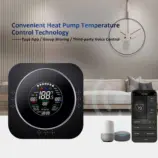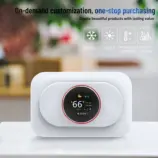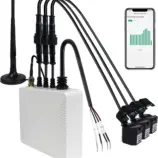⚡ Waarom thermostaatinstellingen belangrijk zijn in 2025
De temperatuur die je op je thermostaat instelt, heeft niet alleen invloed op je comfort. Het beïnvloedt ook je maandelijkse energierekening, de CO2-voetafdruk van je huis en zelfs je gezondheid tijdens extreem weer. Nu de klimaatomstandigheden onvoorspelbaarder worden en de energiekosten stijgen, is het belangrijker dan ooit om de optimale thermostaatinstellingen te begrijpen.
In deze gids leggen we je het volgende uit:
- De ideale binnentemperaturen voorzomer en winter
- HowSlimme thermostatende efficiëntie verbeteren
- Energiebesparende strategieënom u te helpen kosten te besparen
- Praktische stappen voor het juist instellen van uw thermostaat (gedetailleerde gids hier)
☀️ Optimale thermostaatinstellingen voor de zomer
Aanbevolen instellingen
Volgens het Amerikaanse ministerie van Energie is de aanbevolen thermostaatinstelling voor de zomer:78°F (25.5°C)wanneer u thuis bent. Voor ruimtes zonder personeel, verhoog het naar85°F (29.4°C)of hoger om energie te besparen.
| Scenario | Aanbevolen instelling |
|---|---|
| Bezette ruimtes | 78°F (25,5°C) tot 82°F (27,8°C) |
| Hoge luchtvochtigheid/buitentemperaturen | 24°C tot 26°C |
| Goed geïsoleerde huizen | 26°C tot 28°C |
| Actieve zones (sportscholen/woonkamers) | 24°C tot 27°C |
| Onbezette ruimtes | 85°F tot 90°F |
Energiebesparende tips voor de zomer:
- Koel uw huis voorvóór de piekuren
- Gebruik plafondventilatorenom koele lucht te laten circuleren
- Houd de jaloezieën geslotentijdens zonnige uren
Heeft u hulp nodig bij het automatisch beheren hiervan?slimme thermostaat voor warmtepompenkan dit allemaal voor u plannen.
❄️ Optimale thermostaatinstellingen voor de winter
Aanbevolen instellingen
Verwarmingsexperts raden aan om uw thermostaat op68°F (20°C)als je thuis bent en wakker, en het verlagen naar61°F (16°C)wanneer je slaapt of weg bent.
| Kamertype | Voorgesteld bereik |
|---|---|
| Belangrijkste woonruimtes | 18°C tot 22°C |
| Slaapkamers | 61°F tot 68°F |
| Gastenkamers | 15°C tot 18°C |
Energiebesparende tips voor de winter:
- Lagere temperaturen 's nachtsof wanneer je weg bent
- Lekken dichtenrond ramen en deuren
- Gebruik gordijnenom 's nachts warmte vast te houden
- Zorg voor een goede isolatiein muren en zolder
🔧 Hoe stel je een thermostaat in: Snelle handleiding voor beginners
Als u nieuw bent met thermostaten - handmatig of programmeerbaar - vindt u hier een eenvoudig overzicht, aangepast vanDe volledige handleiding van WikiHow:
- Ken uw thermostaattype: Handmatig, programmeerbaar of slim. Slimme thermostaten bieden de meeste flexibiliteit en automatisering.
- Stel de modus in: Kies “Koel” in de zomer en “Warm” in de winter.
- Pas het instelpunt aan: Gebruik de pijltjes omhoog/omlaag of de draaiknop om de gewenste temperatuur in te stellen.
- Een schema programmeren(voor programmeerbare modellen): Stel dagelijkse of wekelijkse schema's in om de temperatuur automatisch aan te passen wanneer u weg bent of slaapt.
- Gebruik de vakantie- of afwezigheidsmodus: Bij langere afwezigheid kunt u de thermostaat op een energiebesparende stand zetten.
Voor stapsgewijze instructies, zie de volledigeHandleiding voor het instellen van een thermostaat.
🔌 Slimme thermostaten: automatiseer comfort en bespaar kosten
Waarom upgraden naar een slimme thermostaat?
Slimme thermostaten doen meer dan alleen de temperatuur regelen. Ze optimaliseren het energieverbruik op basis van:
- Bezettingsgraad patronen
- Weersomstandigheden
- Uw persoonlijke gewoontes
Belangrijkste voordelen
- Automatische planningvoor verwarming en koeling
- Afstandsbedieningvia app (perfect voor op reis of werk)
- Leeralgoritmendie de efficiëntie in de loop van de tijd verbeteren
- Spraakbesturingvia Alexa/Google Assistent
Verken de opties van Grus:
✨ 8 professionele tips om de efficiëntie te maximaliseren
- Stel een seizoensgebonden basislijn in: 26°C in de zomer, 20°C in de winter
- Aanpassen voor bezetting: Lagere temperatuur in ongebruikte kamers
- Gebruik slimme schema'svoor dag/nachtvariaties
- Afdichten en isolerenuw huis goed
- Maak gebruik van passieve verwarming/koeling(zonlicht, jaloezieën)
- Installeer zonesystemenindien mogelijk
- Onderhoud HVAC-apparatuurregelmatig
- Gebruik de vakantiemodustijdens het reizen
🔥 Herinnering aan extreem weer: blijf veilig
Tijdensextreme hitte of kouthermostaatinstellingen worden cruciaal voor de gezondheid, niet alleen voor comfort. VolgensDe New York Times, hoge temperaturen kunnen de hersenfunctie aantasten, medische aandoeningen verergeren en de slaap verstoren.
Voor seizoensgebonden veiligheidstips, bekijk ons volledige artikel opHoe blijf je koel tijdens de extreme hitte van 2025?.
Tips voor hittegolven:
- Houd jebinnentemperatuur op 26°C of lager
- Zorg dat je voldoende drinkt en eet waterrijk voedsel (meloen, komkommer)
- Gebruik slimme thermostaten omplan koelere slaapinstellingen's nachts
🚀 Laatste gedachten
Het vinden van de "Goudlokje-zone" van uw thermostaat betekent het in balans brengencomfort, efficiëntie en duurzaamheidMet de juiste strategie en een slimme thermostaat profiteert u van meer controle, lagere energierekeningen en het hele jaar door comfort, ongeacht het weer.
Verbeter vandaag nog uw thuisklimaatstrategie.Ontdek Grus slimme thermostaten →
†



